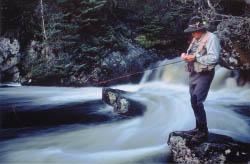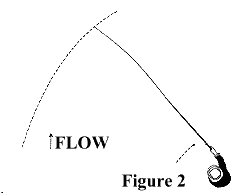The Absolute BEGINNER, Part 2
The best way to learn to fly fish
is by doing it.

By Piscator
TECHNIQUES:
Streamers
You'll find this is the most productive techique. The simplist is to just
cast upstream from the place where you think bass might be holding (fig #1),
 and let the fly drift down and swing across the stream. The fly will swim
just beneath the surface. This means that when a fish hits, you'll both see it
and feel it. Point the tip of the rod toward your own bank. This will keep
the line at an angle to the current rather than parallel to it, making the fly
swim across the current towards your bank. As the fly swims towards you,
gradually move the rod tip closer to your bank, keeping pace with the swing of the fly,
maintaining the angle between the rod tip and the fly (fig #2). Try to avoid
and let the fly drift down and swing across the stream. The fly will swim
just beneath the surface. This means that when a fish hits, you'll both see it
and feel it. Point the tip of the rod toward your own bank. This will keep
the line at an angle to the current rather than parallel to it, making the fly
swim across the current towards your bank. As the fly swims towards you,
gradually move the rod tip closer to your bank, keeping pace with the swing of the fly,
maintaining the angle between the rod tip and the fly (fig #2). Try to avoid
 letting the fly simply dangle directly downstream. Once the fly has swung in
close to your bank, give a few twitches (just in case), then lift it off the
water and repeat the process. Practice doing this with as few false casts
as possible, as the fewer you make, the less water will be shed from the fly,
making it sink more quickly when it hits the stream.
letting the fly simply dangle directly downstream. Once the fly has swung in
close to your bank, give a few twitches (just in case), then lift it off the
water and repeat the process. Practice doing this with as few false casts
as possible, as the fewer you make, the less water will be shed from the fly,
making it sink more quickly when it hits the stream.
After a few casts in one place, take a few steps downstream and do it all over
again. You can work your way all the way down a pool, run, or riffle like
this, covering all the likely holding places.
Dry Flies
Smallmouth also hit dry flies. Like trout, they'll feed freely on hatching
flies floating down the stream, but they're much less selective. This means
that during a hatch you can use almost any fly and have fish take it. Smallmouth
will also readily rise to dry flies when there is nothing hatching. All you have
to do is put the fly upstream of them and let it drift down.
You'll find that smallmouth are rarely put off by drag. In fact, skittering the
fly about a bit will often provoke aggressive hits. However, once you've had
the fun of catching a few, it's a good idea to practice getting a drag-free drift to
prepare you for when you go after trout.
A selection of smallmouth flies:
Streamers/lures (sizes #6 - #8)
Mickey Finn
Black Nose Dace
Muddler Minnow
Dry Flies (#6 - #10)
Wulffs
Humpy
Hairwing Caddis
Haystack |
|





